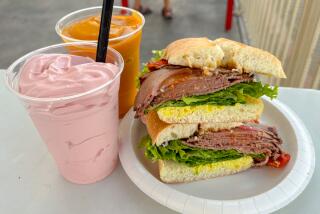Meaty Roundup on the Specialty Range
- Share via
With products like light beer and light pancake syrup crowding supermarket shelves, it’s no wonder meat and poultry growers have come up with a less caloric version of their products too.
Low-fat beef and free-range chickens are showing up more and more on restaurant menus and some specialty stores, causing much confusion from consumers who may not know exactly what they are paying for.
Low-fat beef, which accounts for a tiny share of the current beef market, is a special breed of cattle that is anywhere from 25% to 35% lower in fat than comparable cuts of regular beef.
The meat has less fat marbled through it, said Dean Danilson, a director of the American Light Beef Assn., but tenderness is maintained by using younger cattle. Low-fat beef that has the word natural on the label is raised with no hormones, steroids or antibiotics.
Danilson said producers are just beginning to enter the market, and he sees great potential for growth. “The acceptability so far is tremendous,” he said. “even at a price that is 20% higher than regular beef.”
Beef Council Cool
But the California Beef Council isn’t yet touting low-fat beef. For those watching calories and fat intake they suggest using regular beef but lowering portion sizes. “We don’t like the image of someone sitting down to a huge slab of prime rib--that’s not the way people are eating anymore,” said Mary Ryan, a spokeswoman for the council. She questions claims that most cattle are shot up with hormones and steroids and maintains that small portions of beef won’t harm a weight-loss diet.
Free-range chickens differ from regular poultry in that they are given about two square feet of space per bird (other chickens usually get one square foot) and they are allowed to go outside during the day; also, they grow to be bigger because they are kept alive a couple of weeks longer. Some producers are giving up hormones and other chemicals.
The result of being able to move more freely, range-chicken aficionados say, is meat that is a bit firmer but not tough, lower in fat and with more intense chicken flavor. At the Irvine Ranch Farmer’s Market, the range chickens sell for $1.99 a pound, almost double what their other chickens cost.
Is it worth it? Some restaurants think so; 385 North uses range chickens, as does Morton’s. “The taste is incredible,” said Roy Yamaguchi of 385 North, who has been cooking with the range chickens for a year. And Jeff Goetz, manager of the meat department at the Irvine Ranch Farmer’s Market, said more customers are asking for the range chickens. He describes them as having a “gamier” flavor. Those still in the dark about which bird is better are settling it the only fair way: by doing their own side-by-side comparisons.
More to Read
Eat your way across L.A.
Get our weekly Tasting Notes newsletter for reviews, news and more.
You may occasionally receive promotional content from the Los Angeles Times.










